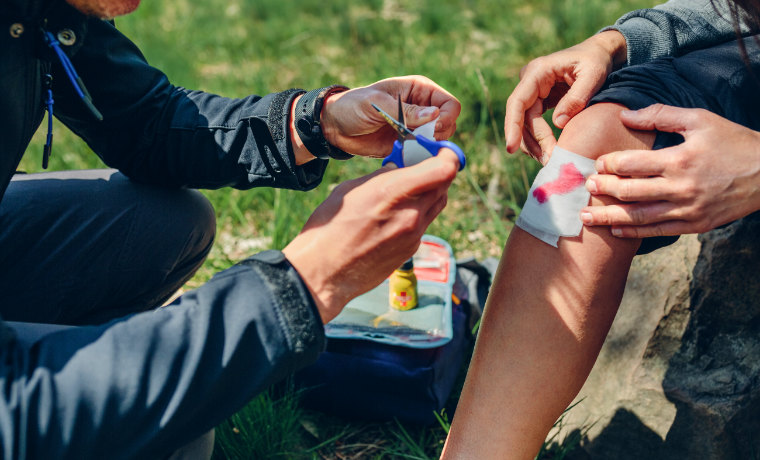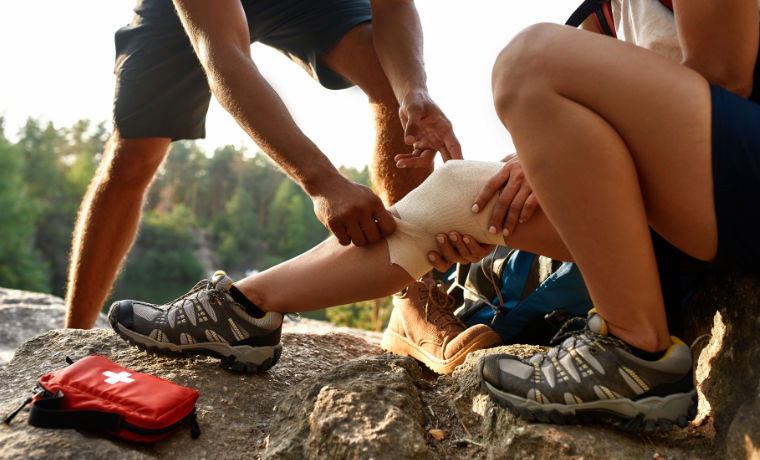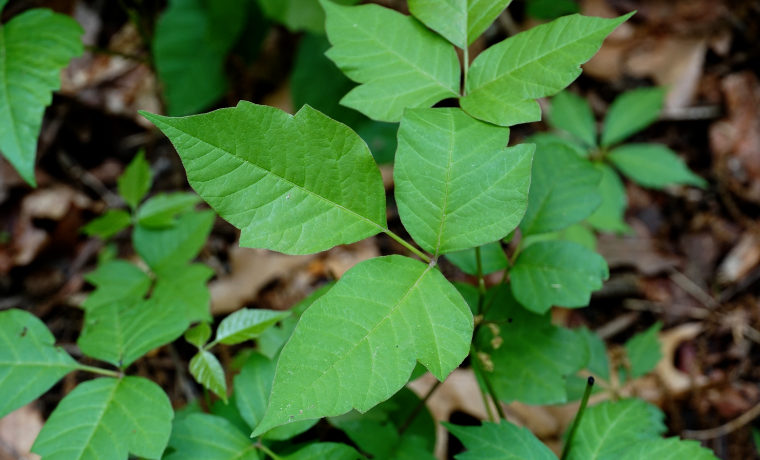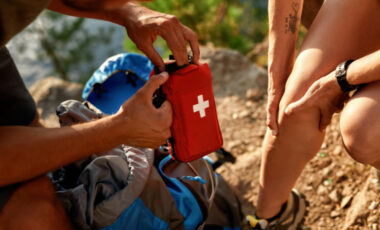Outdoor activities such as hiking, camping and biking can be very enjoyable and rewarding, connecting us with nature and a sense of accomplishment. However, they are not without their risks. Being prepared with knowledge and outdoor first aid supplies is crucial, even for experienced hikers and backpackers. A simple two hour hike can still put you over an hour away from getting help, which can be compounded by lack of cell service.
In this article on basic outdoor first aid, Global Emergency Medics talk through common injuries, preparedness and prevention tips, and outdoor first aid treatments to employ on your own until you can get further assistance. There’s also a handy first aid kit checklist to ensure you have everything you need to mitigate any mountain mishaps as best as possible.
- Scrapes, cuts and flesh wounds
- Sprains and strains
- Common fractures
- Heat related injuries
- Insect bites
- Poisonous plants
- Allergic Reactions
- Outdoor first aid kit checklist
Basic outdoor first aid for common injuries and mishaps

01Scrapes, cuts and flesh wounds
These are some of the most common injuries you could face while hiking and biking, due to falls and other accidents. In order to reduce the probability of these happening, make sure to wear proper gear with protection for your arms, legs and head. Hiking shoes will also aid in preventing you from slipping and falling.
However, if after taking these precautions you were to get hurt, there are safe ways you can treat your injury. The first step is always cleaning and disinfecting the area. Using clean water, rinse the wound thoroughly. If you are dealing with a superficial scrape, you can use hydrogen peroxide or alcohol. However, if it is a deeper cut or flesh wound, antiseptic wipes and sterile saline solution are preferable as they are gentler to the exposed tissues.
Once you have followed the cleaning and disinfection process, apply an antibiotic to the wound in the form of a cream or ointment. Then, cover it using a gauze pad or a sterile adhesive bandage. Take precautions to maintain the wound dry and clean. Lakes and rivers may contain bacteria that could infect the wound, so avoid swimming in them. Make sure to monitor your wound for signs of infection and seek medical help immediately if these start to show.

02Sprains and strains
Most sprains and strains occur in the ankles, knees and wrists. They are usually due to the overstretching or twisting of a muscle or joint. If you happen to suffer from one of these, resting is the first step you should take as it is essential in the initial healing stage.
Make sure that the injured limb is free of all pressure and weight. If possible, also make sure that the affected area is elevated above the heart’s level. This will help to minimize the swelling.
Other great tools to help reduce inflammation are cold compresses as well as ice. Applying these to the affected area will aid in pain relief as well as bring down the swelling. When it comes to compression, if you are using a wrap or elastic bandage you must be careful to not apply it too tightly. Doing this may prevent proper blood flow.
Protecting the injured area is also essential to its recovery. While you sleep, make sure that it is elevated and free of strain and pressure. Avoid all activities that could lead to overuse of the limb, as well as alcohol and heat. And if you observe severe swelling and/or you are in high amounts of pain make sure to seek medical attention immediately.
03Common fractures
Some common fractured areas while doing outdoor activities are wrists and ribs. The distal radius is the most commonly fractured wrist bone. If you suffer from this fracture, the first step is to make sure your wrist is stabilized. You can use a bandana, a stick or other improvised support sources to immobilize the area.
When you create your splint, remember to have it extend from the palm of your hand to the area just beyond the forearm. If possible, elevate the arm that is injured above your heart level as this can aid in pain relief and lowering the inflammation. Ice is also a great tool for swelling reduction.
Rib fractures can potentially be more serious. When severe, they can cause pulmonary contusions, open chest wounds and even collapsed lungs. If you suffer from this fracture, deep breathing can cause excruciating pain; therefore it is encouraged to take shallow breaths instead. This will aid in reducing discomfort. Stabilizing and supporting the chest is essential, using an improvised bandage wrap to immobilize the area. Make sure to exercise caution when applying it so as to not put pressure on the fractured bones.
When a fracture of any kind takes place, these are only the first and most basic actions that should be taken immediately. They should be followed promptly by a professional medical evaluation and care. Prioritizing the stability of the injury and seeking medical attention immediately are the best policies to ensure proper recovery and reduce complications.

04Heat related injuries
If you are exposed to high temperatures for a prolonged period of time, you could suffer from sunburns, heat exhaustion and eventually a heat stroke. Some actions you can take to prevent this are wearing clothing that is light and breathable, staying hydrated, and applying sunscreen. Taking breaks in shaded areas, wearing a hat and sunglasses can also be of help. When you or anyone in your group finds themselves in one of these situations, there are certain measurements that can help to stabilize the person before getting them medical attention.
If you suffer from a sunburn or heat exhaustion, drink lots of fluids with electrolytes, move to a cooler area and elevate the legs slightly. If dealing with a heat stroke, you should call for emergency help immediately. Use any means available such as water and ice packs to cool down the person’s body quickly. Should the person be unconscious or not able to swallow, do not administer fluids as this could lead them to choking.
05Insect bites
When doing any outdoor activities, researching the fauna and flora of the region is essential to identify the species of insects and plants you might encounter in your explorations. Protecting yourself from getting bitten is very important as to avoid allergic reactions and insect-borne diseases, which can cause severe discomfort and pose health risks. Make sure to apply insect repellent and use mosquito nets on your tent if you are camping. Avoid stagnant water bodies such as ponds and lakes. Protect your feet and wear proper clothing that covers most of your skin.

06Poisonous plants
In order to avoid poisonous plants, the first step is to learn to identify them. Familiarize yourself with the shape of their leaves, the areas they like to grow in and other distinctive attributes. Poison ivy, poison oak and water hemlock are some you might encounter in your expeditions. Wearing clothing that covers most of your body, using gloves if you have to touch a plant you are unfamiliar with and staying on the designated trails are all ways to prevent coming into contact with any poisonous species.
07Allergic reactions
In the unfortunate event that you are bitten by an insect or come into contact with a poisonous plant, this could lead to an allergic reaction. If this happens, there are a few things you can do to help bring relief and prevent it from worsening. First, wash the affected area with soap and water to remove the plant’s remaining oils or leftover insect venom. Avoid touching your face and other parts of your body until you do so. Taking antihistamines such as Benadryl and using topical creams such as hydrocortisone can help to reduce some of the allergic symptoms. Lastly, seek medical care as soon as possible, to ensure the reaction does nor worsen or recur as this can happen even after taking the previous measurements.

Carry a well-stocked first aid kit
Lastly, always make sure that your first aid kit is stocked and prepared for any eventuality. Pack antiseptic wipes, antibiotic ointment, bandages, allergy medication and all other essential items.
First aid kit checklist
Global Emergency Medics recommend that a well stocked outdoor first aid kit should include:
Basic Care Supplies
Medications
Wraps, Splints, and Wound Coverings
Tools and Other Supplies
If you follow these prevention tactics and apply these techniques when dealing with outdoor injuries, you will have a safer and smoother experience throughout your exploration journeys!



